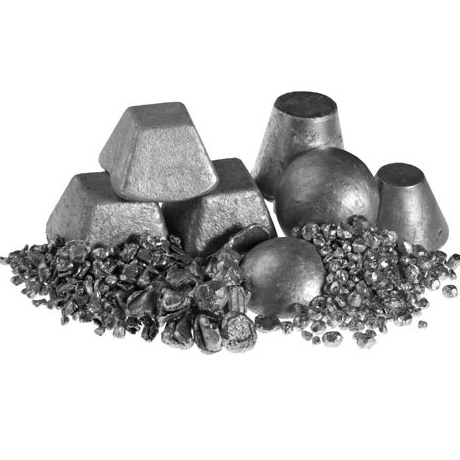Aluminium
Basic facts about Aluminium :
Aluminium is a chemical element with the symbol Al and atomic number 13. It is a silvery-white, soft, non-magnetic and ductile metal in the boron group. Aluminium is the most abundant metallic element in Earth’s crust and the most widely used nonferrous metal. Because of its chemical activity, aluminium never occurs in the metallic form in nature, but its compounds are present to a greater or lesser extent in almost all rocks, animals, and vegetation.
Aluminium is a highly versatile metal– means it can be processed to be thin, lightweight, bendable and even crushable by human hands.
Aluminium is added in small amounts to certain metals to improve their properties for specific uses, as in aluminium bronzes and most magnesium-base alloys; or, for aluminium-base alloys, moderate amounts of other metals and silicon are added to aluminium. The metal and its alloys are used extensively for aircraft construction, building materials, consumer durables (refrigerators, air conditioners, cooking utensils), electrical conductors, and chemical and food-processing equipment. A number of aluminium compounds have important industrial applications. Alumina, which occurs in nature as corundum, is also prepared commercially in large quantities for use in the production of aluminium metal and the manufacture of insulators, spark plugs, and various other products. Upon heating, alumina develops a porous structure, which enables it to adsorb water vapour. This form of aluminium oxide, commercially known as activated alumina, is used for drying gases and certain liquids. It also serves as a carrier for catalysts of various chemical reactions.
The secret to aluminium’s strength comes down to chemistry. Pure aluminium is mixed with other elements to create high-strength alloys. Common additives used to increase the strength and formability of aluminium include silicon, magnesium and copper. Aluminium-zinc alloys are some of the strongest alloys available today and are commonly used by the automotive and aerospace industries.
Aluminium can be further strengthened through processing – hot rolling or cold rolling. Some alloys are made stronger by heat-treating followed by rapid cooling. This process freezes the atoms in place strengthening the final metal. Alternatively, some aluminium is “cold worked” -- usually by rolling, stretching forging or drawing -- to make it stronger. This process inhibits the movement of atoms relative to each other, strengthening the finished product.
USES OF ALUMINIUM
- Automakers are increasingly turning to aluminium as part of the multi-material mix to increase vehicle fuel efficiency while maintaining strength and safety. Every aluminium-intensive vehicle ever crash tested by the National Highway Traffic Safety Administration has earned a 5-star safety rating.
- High-strength aluminium alloys are used in hundreds of everyday applications where strength and durability are essential – from planes to trains, buses to trucks – even some of the world’s tallest skyscrapers.
- By adding elements like silicon, magnesium and lithium to pure aluminium and through special processing techniques, aluminium can be engineered to be as strong if not stronger than some steel.
- Aluminium is used for window frames and curtain wall in some of the world’s tallest skyscrapers. This versatile metal is used to make planes, trains, buses, trucks – even ocean liners!
- Every day, people around the world trust the strength of aluminium – whether they know it or not. It is known for its Extreme Durability. In addition to “everyday” applications, aluminium’s strength and durability is also trusted for some of the most extreme uses imaginable. The inventors and the creators know that high-strength aluminium alloys can handle some of the rasping conditions on earth and beyond.
- Aluminium alloys have replaced older wood, steel, wire and fibre soon after the World War 2. Army has trusted aluminium for decades to help protect the troops. The high-strength, crash-absorbent metal is used in the Fighting Vehicle to reduce weight, resist rust and be reliable under tough conditions. , high-strength aluminium alloys have become among the most commonly used materials to make military aircraft.
- Aluminium Armor plate is even used to resist explosives and other attacks.
- Even when facing one of nature’s ferocious and savage predators – the strength of aluminium is trusted. Aluminium is the popular choice for shark cages because the metal is more preferred than alternatives and won’t corrode in salt water. Aluminium bars are more than strong enough to protect divers from direct attacks from Great White and other sharks.
- Precision Tubing in motor vehicles, refrigerators, air conditioning, solar panels, Power Lines etc.
- Rolled Aluminium products.
- Heat sinks for cooling CPU's and graphics processors.Construction.
Properties of Aluminium
| Atomic symbol | Al |
|---|---|
| Atomic number | 13 |
| Atomic radius, empirical | 143 pm |
| Electron configuration | [Ne] 3s23p1 |
| Density | 2.70 g cm−3 |
| Melting point | 660.323°C, 1220.581°F |
| Boiling point | 2519°C, 4566°F |
| Relative atomic mass | 26.982 |
| Key isotopes | 27Al |
| Covalent radius | 1.24 Å |
| Atomic radius, non-bonded | 1.84 Å |
| Electronegativity Pauling scale | 1.61 |
| Heat of fusion | 10.71 kJ/mol |
| Heat of vaporization | 284 kJ/mol |
| Molar heat capacity | 24.20 J/(mol·K) |
| Covalent radius | 121±4 pm |
| Mohs hardness | 2.75 |
| Thermal expansion | 23.1 µm/(m·K) (at 25 °C) |
| Thermal conductivity | 237 W/(m·K) |
| Electrical resistivity | 26.5 nΩ·m (at 20 °C) |
